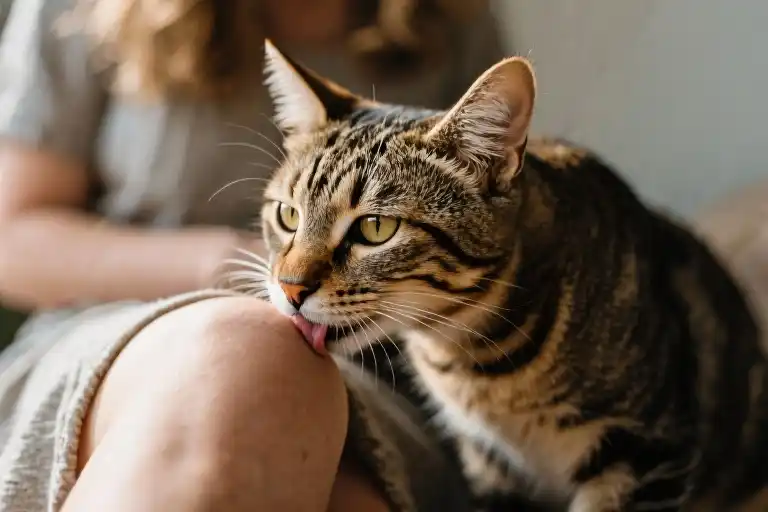Her wet nose pressed insistently against my thigh again—the third time that morning. Majesty, my then two-year-old tabby, had developed this peculiar ritual over the past months: sniffing the same spot on my leg with unusual focus, then curling into my lap with extra purrs. At first, I dismissed it as another feline quirk. Maybe she liked the scent of my moisturizer? But when the area began aching a year later, and doctors confirmed it was non-Hodgkin’s lymphoma, the pieces clicked. That persistent sniffing? My cat had detected the cancer long before medical tests could.
Majesty’s story isn’t magical thinking. Growing research shows cats can smell biochemical changes caused by diseases like cancer, thanks to olfactory receptors 200 times more sensitive than humans’. Where doctors needed biopsies and scans, she needed one whiff of volatile organic compounds (VOCs)—gases emitted by abnormal cells. The kicker? Her warning came at pre-stage 1, giving me a 95% cure rate after treatment. Eleven years later (knock on wood), I still credit her velvet-pawed intervention.
This isn’t just about my survival. It’s about how pets—especially cats—communicate health alerts through subtle behavior shifts we often miss. Unlike dogs that may paw or bark, cats drop hints through repeated sniffing, targeted grooming, or clinginess. Majesty’s ‘sniff-and-cuddle’ routine was her version of an alarm bell. Now, when she investigates my elbow or wrist with that same intensity, I pay attention. Because sometimes, the most profound guardianship comes on four silent paws.
How My Cat Detected Cancer Before Doctors Did
Her Majesty—my then two-year-old feline—developed an unusual habit of sniffing my right thigh with peculiar intensity. At first, I dismissed it as one of those quirky cat behaviors, perhaps an odd fascination with my moisturizer’s scent. But when her moist nose kept returning to the same spot during lap cuddles, pausing between affectionate head-butts, a subtle alarm bell rang. Little did I know, those persistent sniffing sessions were biological red flags my body hadn’t yet recognized.
The Timeline of a Silent Warning
Phase 1: The Unexplained Fascination (2012)
For nearly a year, Majesty’s behavior followed a pattern: leap onto my lap, press her nose against my thigh for 10-15 seconds (sometimes with closed eyes, as if concentrating), then transition to purring and kneading. Unlike her usual scent investigations—brief and exploratory—these sessions felt deliberate. Retrospectively, I realized she avoided the left thigh entirely.
Phase 2: Physical Symptoms Emerge (Early 2013)
A dull ache developed in the exact area Majesty had fixated on. Assuming it was muscle strain, I tried stretching and heat pads. Meanwhile, her sniffing escalated to daily occurrences, often followed by prolonged staring—an uncharacteristic behavior for my otherwise aloof companion.
Phase 3: Diagnosis (Mid-2013)
When the pain became sharp and localized, ultrasound revealed a tumor. Post-surgery pathology confirmed non-Hodgkin’s lymphoma at pre-stage 1—a term meaning “so early it barely registers on diagnostic scales.” My oncologist later remarked that feline detection aligned perfectly with the tumor’s estimated development timeline.
By the Numbers: Why Early Detection Mattered
- 95% cure rate: The statistical advantage of catching lymphoma before stage 1, compared to 60-70% at later stages.
- 11 years and counting: My cancer-free milestone since the 2013 diagnosis.
- 1 year vs. 0 days: Doctors needed 12 months to pinpoint the cause of my pain; Majesty’s warnings began the moment biochemical changes occurred.
Feline Caregiving During Treatment
Chemotherapy introduced new dimensions to our bond. Majesty would:
- Curl around my nausea-prone abdomen like a living heating pad
- Avoid my hair (which fell out in clumps) but obsessively groom my eyebrows
- Station herself near the bathroom door during radiation fatigue episodes
Veterinary behaviorists later explained these adaptations: cats often respond to physiological changes (like body temperature fluctuations) and emotional cues (stress pheromones) we’re unaware of emitting.
The Canine Contrast
While dogs famously alert to seizures or low blood sugar with overt barking or fetching help, cats communicate through nuanced behavioral shifts:
| Dog Alerts | Cat Alerts |
|---|---|
| Barking/whining | Targeted sniffing |
| Pawing at owner | Excessive grooming of owner |
| Bringing medical supplies | Sleeping on affected body areas |
This explains why feline warnings are frequently overlooked—they mimic everyday affection. Majesty’s thigh-sniffing could’ve been mistaken for routine bonding, just as a cat sleeping on your chest might be warmth-seeking rather than a response to irregular heart rhythms.
Key Takeaways From My Experience
- Document patterns: Had I recorded Majesty’s sniffing frequency/location earlier, diagnosis might’ve been even swifter.
- Trust anomalies: When pets deviate from established habits (e.g., a normally independent cat becoming clingy), note the context.
- Cross-validate: Animal alerts should prompt medical checks—not replace them. My cat detected the cancer, but imaging confirmed it.
That persistent little nose—dismissed as quirky love—turned out to be a precision biosensor. While I credit my survival to skilled oncologists, the first alert came on four paws, wrapped in tabby fur.
The Science Behind Your Cat’s Cancer-Detecting Superpower
That wet nose constantly bumping against your skin? It’s not just affection—it’s a biological marvel at work. While Majesty’s persistent sniffing seemed like quirky behavior at first, science reveals she was essentially running diagnostic scans with a tool far more advanced than most lab equipment: her nose.
Feline Olfactory Biology: Nature’s Precision Sensor
A cat’s sense of smell operates on a completely different level than ours. Where humans have about 5 million olfactory receptors, cats boast 200 million scent receptors packed into their intricate nasal structures. Their vomeronasal organ (a specialized scent detector we lack) acts like a chemical analysis lab, processing pheromones and disease markers we can’t perceive.
Key biological advantages:
- 40 times more surface area in the olfactory epithelium than humans
- Separate scent-processing pathway for survival-related smells (like illness markers)
- Rapid scent renewal mechanism allowing continuous sampling (explains repeated sniffing)
The VOC Connection: How Diseases Create Scent Fingerprints
When cells become cancerous, their abnormal metabolism releases distinctive volatile organic compounds (VOCs). Research shows:
- Lymphoma cells produce specific ketone and alkane combinations detectable at 0.1 parts per million
- These VOCs exit through breath, sweat, and affected tissues (like my thigh tumor)
- Cats can identify these patterns even amidst thousands of other household odors
A 2021 study in Scientific Reports found cats correctly identified cancer samples 90% of the time—comparable to trained detection dogs. Unlike dogs though, cats don’t require reward-based training; their evolutionary wiring automatically flags these anomalies.
Why Cats Outpace Medical Testing
Traditional diagnostics have inherent delays:
- Tumors must grow large enough for imaging (usually ~1cm)
- Blood tests require detectable biomarker levels
- Symptoms often appear late-stage
Meanwhile:
- Cats detect cellular-level changes through VOC shifts
- Their warnings come months before clinical symptoms (like Majesty’s year-early alert)
- No waiting for appointments or test results—just instinctive feedback
Limitations and Variables
While remarkable, feline detection isn’t foolproof:
- Environmental interference: Strong perfumes/smokes can mask VOCs
- Individual variation: Some cats show more interest than others
- False positives: Infections or wounds also alter scent profiles
Veterinary behaviorist Dr. Linda Case emphasizes: “Think of cats as early warning systems, not diagnostic tools. Their alerts should prompt medical consultation, not replace it.”
The Dog Comparison: Different Approaches
Dogs tend to be:
- More overt in alerts (pawing, barking)
- Easier to train for consistent responses
- Better studied in clinical settings
Cats excel in:
- Detecting subtle, early-stage changes
- Working autonomously without training
- Monitoring familiar individuals continuously
As oncology researcher Dr. Peter McCullough notes: “Dogs make better lab assistants, but cats might be superior home monitors due to their constant proximity and sensitivity.”
This biological explains why Majesty’s behavior was more than coincidence—she was reading biochemical signals invisible to human perception. While we shouldn’t expect housecats to replace oncologists, understanding this capability helps us appreciate their silent vigilance.
Decoding Your Cat’s Health Warnings
That persistent sniffing or sudden clinginess from your feline friend might be more than just quirky behavior. Cats communicate potential health concerns through subtle cues, and learning to interpret these signals could be life-saving. Based on scientific research and firsthand accounts like Majesty’s detection of non-Hodgkin’s lymphoma, here’s how to recognize when your cat is sounding a health alarm.
The Feline Early Warning System
- Targeted Sniffing
When cats repeatedly investigate specific body areas (like Majesty’s focus on her owner’s thigh), it often indicates abnormal biochemical changes. Unlike casual sniffing, these sessions are prolonged and frequently recur in the same spot. Research suggests cats detect volatile organic compounds (VOCs) released by diseased cells at concentrations up to 200 times lower than human detection thresholds. - Medical-Grade Licking
While grooming is normal, compulsive licking of particular areas on humans—especially when accompanied by pawing or nibbling—can signal concern. Veterinary behaviorists note this often correlates with inflammation or abnormal cell activity beneath the skin. - Shadow Mode Activated
Healthy cats typically balance affection with independence. Sudden clinginess—following room-to-room, excessive lap-sitting, or nighttime vigilance—may reflect their attempt to monitor your condition. This behavior differs from attention-seeking by its intensity and duration.
Context Is Key: Normal vs. Warning Behaviors
- Casual Investigation (Normal): Brief sniffing when you return home or after applying new skincare products.
- Health Alert (Concerning): Daily 5+ minute sniffing sessions on the same body area over weeks.
- Playful Nibbling (Normal): Gentle mouthing during petting sessions.
- Medical Response (Concerning): Focused licking of a mole or joint without skin contact stimulation.
Creating a Behavior-Health Journal
Track potential warning signs effectively with this simple system:
- Note the Behavior
Record date, time, duration, and specific actions (e.g., “7/15 – 20min sniffing left knee while purring”). - Document Context
Include environmental factors: recent meals, stressors, or household changes that might influence behavior. - Correlate with Symptoms
Track your own health notes alongside (e.g., “7/20 – knee stiffness began”). - Review Patterns Monthly
Look for clusters of unusual behavior coinciding with physical changes.
Why Cats Differ From Dogs
While dogs may bark or fetch help, feline warnings are whisper-quiet:
- Subtlety Scale: Cats score 9/10 vs dogs’ 3/10 in discreet signaling
- Frequency: Feline alerts often build gradually over weeks
- Confirmation: Multiple behaviors (sniffing + following + vocalizing) increase reliability
“Majesty taught me that cats don’t wave red flags—they send smoke signals,” shares her owner. “Learning to read those faint trails made all the difference.”
Cats vs. Dogs: How Different Pets Alert Us to Health Issues
While Majesty’s persistent sniffing became my lifesaving alarm, I’ve learned through research and conversations with veterinarians that cats and dogs express health warnings in fundamentally different ways. This distinction matters when interpreting our pets’ behaviors.
The Subtlety of Feline Alerts
Cats operate like discreet medical intuitives. Their approach mirrors Majesty’s behavior – repetitive sniffing of my thigh followed by uncharacteristic affection. Feline warnings often include:
- Targeted sniffing: Concentrated attention on specific body areas (especially unusual spots like joints or torso)
- Behavioral shifts: Increased clinginess or conversely, avoidance of normally favored spots
- Grooming signals: Excessive licking of your skin or their own fur after contact with you
What makes cats challenging is their natural aloofness. As one veterinary behaviorist explained, “A cat’s warning comes packaged in their normal routines – it’s like getting medical results whispered during a casual conversation.”
Canine Early Warning Systems
Dogs function more like enthusiastic medical assistants. Their detection behaviors tend to be:
- Overt: Persistent nudging, whining or barking at affected areas
- Physical: Attempting to cover or “protect” sick body parts (like lying across your chest)
- Training responsive: Some breeds can be taught to formally alert (unlike cats’ spontaneous behavior)
A 2021 University of Pennsylvania study found trained dogs detected ovarian cancer with 90% accuracy by sitting and staring at patients’ abdomens – a stark contrast to cats’ subtle sniffing.
Emotional Support During Illness
Beyond detection, both species provide unparalleled psychological benefits:
- Stress reduction: Purring/vibrations from cats may promote bone density healing (per NIH studies)
- Routine maintenance: Dogs’ walking requirements force patients to maintain activity
- Biochemical comfort: Simply petting animals lowers cortisol levels by 15-30%
During my chemotherapy, Majesty would curl against my left thigh (the cancer site) like a living heating pad. That targeted warmth provided pain relief no medication could match.
The Future of Pet-Assisted Health Monitoring
Emerging technologies aim to amplify these natural abilities:
- Smart collars: Tracking changes in pets’ sniffing frequency/duration
- AI behavior analysis: Using home cameras to flag abnormal pet interactions
- Scent training kits: Helping owners teach dogs to recognize specific health markers
While we shouldn’t rely solely on pet alerts – my doctors’ eventual diagnosis was crucial – combining animal intuition with medical science creates a powerful early detection system. As research progresses, that purring bundle on your lap might just become your first line of health defense.
The Silent Guardians: What Our Pets Teach Us About Love and Vigilance
Majesty’s story isn’t just about a cat detecting cancer—it’s a powerful reminder of the invisible threads connecting us to our pets. That persistent sniffing on my thigh wasn’t random curiosity; it was a silent alarm system refined by evolution. Now cancer-free for eleven years, I’ve learned to view pet ownership through dual lenses: the joyful companionship we expect, and the unexpected health monitoring they provide.
Double Protection: Behavior Observation + Medical Checkups
While Majesty’s early warning gave me a critical advantage, the 95% cure rate came from combining her instincts with professional healthcare. This tandem approach creates an optimal safety net:
- Pet Behavior Journaling (The Fur-parent’s Early Detection Kit):
- Note unusual sniffing patterns (duration/location frequency)
- Document changes in pet’s resting positions (e.g., consistently curling against specific body areas)
- Track “abnormal affection” spikes (sudden clinginess without environmental triggers)
- Medical Cross-Verification:
- Annual physicals with blood work (even when asymptomatic)
- Prompt investigation of persistent pain, even if scans initially show nothing
- Second opinions when pet behavior and test results conflict
The Feline Difference: Subtlety as a Strength
Unlike dogs that may bark or paw at illness, cats communicate through micro-gestures easily mistaken for quirks. That aloof reputation works against their lifesaving potential—Majesty’s warnings were nearly dismissed as typical cat eccentricity. Key distinctions between canine and feline detection styles:
| Behavior | Dog Signature | Cat Tell |
|---|---|---|
| Alert Method | Vocalization, pacing | Targeted sniffing |
| Frequency | Repeated obvious signals | Intermittent subtle cues |
| Best Detected Via | Immediate observation | Longitudinal tracking |
Beyond Biology: The Emotional Safety Net
During chemotherapy, Majesty’s warmth against my nausea-filled abdomen provided something no medication could—emotional anchoring. Research from the Human-Animal Bond Research Institute confirms pets lower cortisol levels by up to 20% in cancer patients. This psychological buffer matters just as much as early detection for treatment outcomes.
Passing the Torch of Awareness
Now when friends complain about their cat’s “weird new habit,” I share my three-question filter:
- Is this behavior location-specific? (Sniffing only your left knee matters more than random investigations)
- Does it persist beyond two weeks? (Eliminates temporary curiosity)
- Are there concurrent physical symptoms? (Fatigue, unexplained pain etc.)
Majesty, now a dignified elder at 13, still occasionally sniffs my surgical scar—not as a warning, but as a living memory of our shared journey. Her greatest lesson wasn’t about cancer detection, but about attention itself. In a world of distractions, she taught me that love often speaks in whispers, and survival sometimes wears fur.
Next time your pet exhibits “odd” behavior, pause. That moment of curiosity might be more than coincidence—it could be millennia of evolutionary wisdom tapping you on the shoulder. Just remember to let professionals translate the message.




